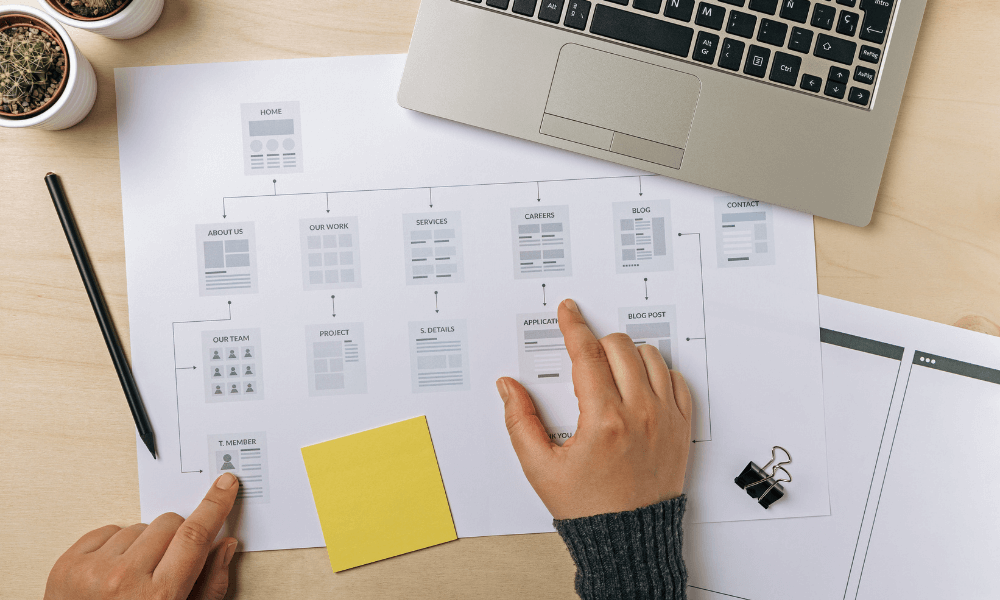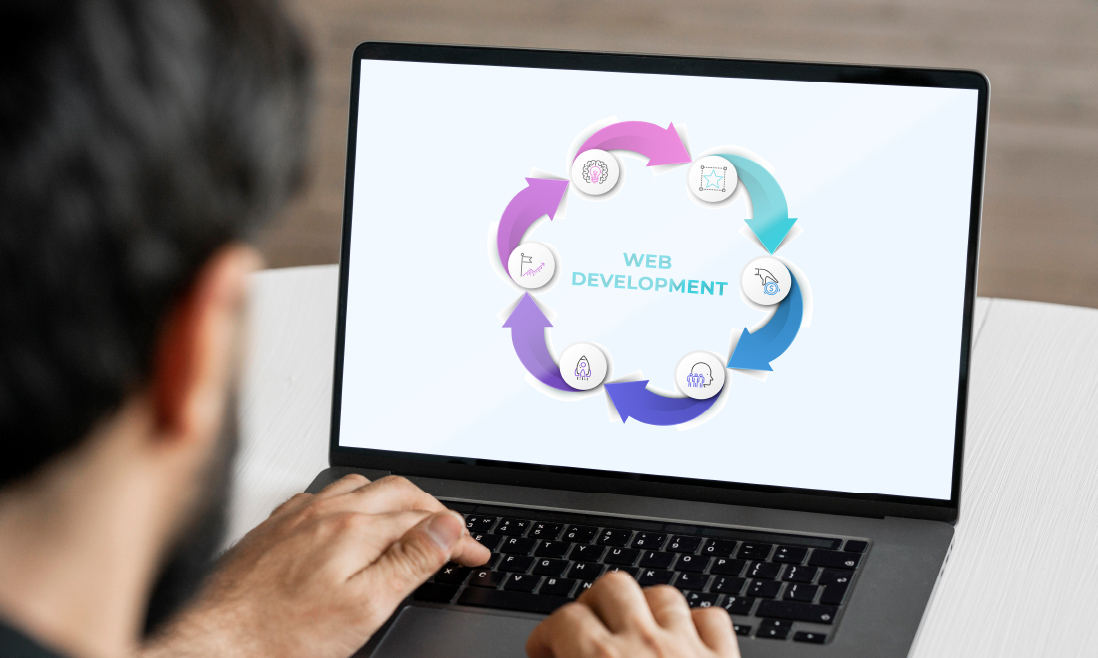Creating a website is a lot like constructing a building. It requires careful planning, designing, building, testing, and maintaining to ensure it stands strong and serves its purpose.
This process, known as the Web Development Life Cycle (WDLC), is a structured journey that guides developers and project managers from an initial concept to a fully functioning digital presence.
Just as a house needs a blueprint, a team, and a plan to prevent chaos, the WDLC acts as the blueprint for creating and maintaining websites and web applications. It’s a flexible process, adaptable to various projects – from simple webpages to complex social networks.
Understanding the WDLC is crucial for creating websites that not only meet but exceed expectations. In this blog post, we’ll explore how understanding the core purpose of your website, knowing your audience, and meticulously planning content and functionality leads to a robust and user-friendly website.
What is The Web Development Life Cycle?
At its core, the web development life cycle is a structured journey, a roadmap guiding developers and project managers from the initial idea to a fully functioning digital presence. It’s about building bridges between the client’s vision and the end user’s needs, ensuring the final product resonates with its audience while staying efficient and effective in its construction.
Imagine building a house. Without a blueprint, team, or plan, the process would be chaotic and the result, uncertain. This is where the WDLC steps in, serving as the blueprint for creating and maintaining websites and web applications.
The WDLC is not a one-size-fits-all process; it’s as diverse as the web itself. Whether it’s crafting a simple webpage or engineering a complex social network, this lifecycle adapts, ensuring that each project receives a tailor-made approach. It’s about turning a kaleidoscope of ideas into a coherent, well-functioning website.
A web development life cycle typically has 5 main stages:
- Planning
- Analysis
- Design and development
- Testing
- Implementation and maintenance
Every stage of the WDLC is a step in a journey towards digital excellence. In the next sections, we’re going to dive deep into each stage to see what they entail.
Stage 1: Planning

The planning stage is the cornerstone of web development. Like architects planning a building, this stage is about setting a clear vision for your website.
The ‘Why’ Behind Your Website
The first step is understanding the core purpose of your website. Ask yourself, “What do I want this website to achieve?”
This could range from providing information, selling products or services, to serving as a digital hub for community interaction. The clearer the purpose, the more focused your development efforts will be.
What are the main objectives of your website?
Is it to inform, engage, entertain, or sell? Defining clear, measurable goals at this stage will shape your website’s structure and content strategy.
Knowing Your Audience
Understanding your audience is akin to knowing your guests before throwing a party. It’s essential to ask, “Who will use this website?”
No need to overthink here, as your product or service already defines your audience. For instance, premium pet food targets pet owners with disposable income.
Go beyond basic demographics. Imagine the daily life of your potential visitors. What are their likes, dislikes, online habits, and preferences? Methods like online surveys, product trials, and interviews can offer invaluable insights into your target audience’s psyche.
Your website should resonate with your audience, be it in terms of content, design, or functionality. Consider their age, gender, computer literacy, and preferences. This insight guides not just the look and feel of the website, but also the technologies and tools you’ll choose to build it.
Stage 2: Analysis

The analysis stage is where the conceptual vision of your website starts transforming into a tangible blueprint.
Content and Functionality Decisions
This is about more than just what your website will contain; it’s about how it will interact with its users. Here, every feature, from the simplest contact form to complex dynamic elements, is planned out. This step ensures that your website not only informs but also engages your audience effectively.
- Content Mapping: The heart of this stage is content analysis. What will your website say? How will it say it? This involves creating a detailed map of the website content, covering not just the topics but also the depth and breadth of information. It’s about ensuring that every piece of content serves a purpose and aligns with your overall objectives.
- Functional Requirements: Here, you detail the features and functionalities your website will offer. This includes everything from user interaction features, e-commerce capabilities, to any specialized functions unique to your website. Think of it as listing the ‘what’ your website will do for its users.
Non-Functional Requirements
While the functionalities define what a website does, non-functional requirements shape how well it performs these tasks. They are all essentials: performance, security, and usability.
It’s about ensuring that your website is not only capable but also efficient, secure, and user-friendly, delivering a seamless experience to every visitor.
- Performance: How fast will your website load? How much traffic can it handle? Performance requirements set the standards for your website’s operational efficiency.
- Security: In an age where data breaches are common, outlining security measures is crucial. This includes data protection, secure transactions, and safeguarding user privacy.
- Usability: This involves ensuring the website is user-friendly and accessible to all potential users, including those with disabilities. Usability influences design decisions like layout, navigation, and readability.
Technical Feasibility and Infrastructure
Turning a vision into reality often hinges on the technical groundwork laid during the analysis phase. Here, the focus is on assessing the technical feasibility of your planned features and choosing the right technology stack and infrastructure.
- Assessing Technical Viability: Not all great ideas are technically feasible within given constraints. This step involves evaluating whether the proposed features can be developed within the time and budget constraints.
- Technology and Compatibility: Selecting the right technology stack is critical. It includes decisions about programming languages, content management systems, and ensuring compatibility across different browsers and devices.
- Infrastructure Needs: Assessing server requirements, hosting solutions, and any other technical infrastructure needed to support your website’s functionality and traffic projections.
Defining User Roles and Access Levels
This segmentation of roles is critical for maintaining the integrity, security, and orderly management of the website. It becomes especially important for websites with multiple contributors or those that handle sensitive user information.
For example, a content management system might have various roles, such as administrators, editors, contributors, and subscribers, each with distinct levels of access and control.
Administrators may have complete control over the website, including the ability to add or remove users, change settings, and oversee all content. Editors might be responsible for reviewing and publishing content, but without the broader site-control capabilities of administrators.
Contributors could be allowed to create and submit content but not publish it, while subscribers might only have access to view certain content.
By clearly defining these roles and access levels, you can ensure that each user has the necessary tools and permissions to perform their tasks efficiently, without compromising the site’s security or functionality.
Stage 3: Design and development

After establishing the purpose and planning the content, the next critical stage in the Web Development Life Cycle is Design and Development. This stage is where your website starts taking a visual and functional form.
Design
The design phase is where your website’s visual identity and user experience come to life. It involves a series of steps that ensure the final product is not only visually appealing but also functional and user-friendly.
Wireframing and Prototyping
This initial step involves creating wireframes that provide a basic structure of the website’s layout. These are typically low-fidelity sketches that map out essential elements and user flow. The process then advances to developing high-fidelity prototypes, which are more detailed and closer to the final design.
These prototypes are crucial for testing and refining user experience, allowing designers to simulate how users will interact with the site and make adjustments based on feedback.
Visual Design
This stage is about translating the brand’s identity into the digital space. Designers select color schemes, typography, and imagery that align with the brand’s ethos and appeal to the target audience. The focus here is on creating a cohesive and aesthetically pleasing interface that enhances user engagement. Visual consistency across all pages is key to providing a seamless user experience.
Usability and Accessibility
Designing for accessibility means ensuring that the website is navigable and usable for all users, including those with disabilities. This could involve implementing features like keyboard navigation, screen reader compatibility, and alternative text for images. Usability testing is employed to identify areas where users might struggle and to refine the design accordingly.
Development
The development phase is where the designed website is brought to life through coding. This phase is divided into two main areas:
1. Front-End Development:
Front-end developers take the design prototypes and turn them into a working website. They use HTML for the structure, CSS for the design, and JavaScript for the functionality.
This stage involves a lot of testing and tweaking to ensure that the site looks good and works well on all browsers and devices. Responsive design is crucial here, ensuring the website adapts to different screen sizes, especially for mobile users.
2. Back-End Development:
Back-end development focuses on the server-side of the website. This includes server and database management, API integration, and ensuring that all the data-driven components of the site function seamlessly.
Languages and frameworks like PHP, Python, Ruby on Rails, and Node.js are commonly used. This phase is critical for functionalities like form submissions, user authentication, and e-commerce transactions.
Additional Considerations
Design and development are not linear processes; they involve continuous iterations and refinements. Regular communication and collaboration between designers, developers, and stakeholders are essential for aligning the final product with the envisioned goals.
Employing version control systems like Git is crucial for tracking changes, managing different versions of the project, and facilitating collaboration among team members. It ensures that any changes or additions to the codebase are documented and reversible if needed.
Throughout this phase, collecting and integrating feedback from stakeholders, potential users, and testing is vital. This helps in fine-tuning both the design and functionality of the website, ensuring it meets user needs and expectations.
Stage 4: Testing

Testing is a critical phase in the web development life cycle, dedicated to rigorously scrutinizing every aspect of the website. It’s the stage where the functionality, user experience, and overall performance of the website are put under the microscope.
The aim here is not just to identify bugs but to ensure that the website meets the highest standards of quality and reliability before it goes live.
1. Unit Testing
Unit testing focuses on the smallest parts of the application – the individual units of code. Developers test functions, modules, and classes to ensure they function correctly in isolation. This step is integral in catching issues early in the development process, making it easier to address them.
2. Integration Testing
After unit testing, the next step is integration testing. This process involves combining individual units and testing them as a group. The goal is to ensure that different parts of the website interact seamlessly and function as a coherent whole.
3. System Testing
System testing examines the complete and fully integrated software product. This comprehensive testing ensures that the entire system meets the specified requirements and functions correctly in all scenarios.
4. User Acceptance Testing (UAT)
User Acceptance Testing involves real-world users testing the website. It’s a crucial step in evaluating the website’s usability, accessibility, and overall user experience. UAT helps in understanding how the website will perform in the hands of its intended users.
5. Performance Testing
Performance testing assesses the website’s speed, responsiveness, and stability under various conditions. It ensures the site can handle expected traffic volumes and interactions without compromising on user experience.
6. Security Testing
Security testing is vital in today’s digital landscape. This step identifies vulnerabilities and security gaps, safeguarding the website against potential attacks and data breaches.
7. Compatibility Testing
Compatibility testing verifies that the website functions correctly across different browsers, devices, and operating systems. This ensures a consistent and accessible user experience for all visitors, regardless of their choice of technology.
8. Regression Testing
Following any changes or updates to the website, regression testing is conducted. This helps ensure that the new changes haven’t adversely affected existing functionalities.
By the end of Stage 4, your website should have undergone extensive testing, ensuring that it’s not only bug-free but also delivers a seamless, secure, and pleasant user experience. This stage is crucial in building confidence – both in your team and your future users – that your website is ready for the digital world.
Stage 5: Implementation and maintenance

The final stage in the web development life cycle is both a culmination of all the hard work and the beginning of an ongoing journey. Implementation and maintenance are where your website takes its first steps into the digital world and continues to evolve and adapt.
Implementation
The implementation phase is like your website’s grand opening. This is when the website goes from being a project to something people can visit on the internet. It’s about getting your site onto a live server and giving it a unique address (or domain name) so people can find it.
But being online isn’t enough; you want people to easily find your site through search engines. This is where SEO, or Search Engine Optimization, comes in. It helps your website show up in search results. Besides, it’s important to know how your site is doing and what visitors think of it. Adding tools like Google Analytics can give you this information.
Lastly, security is super important. You need to protect your website from online threats, so your visitors feel safe.
Maintaining Your Website
After your website is up and running, you need to take care of it, just like you would with a car or a house. This means fixing any problems, known as bugs, that pop up. It’s also about keeping the website interesting and up-to-date with new content.
You want your website to be fast and work well all the time, so checking and improving its performance is a big part of maintenance. As new online threats appear, updating your website’s security is crucial.
Also, keeping an eye on the website’s overall health makes sure it’s always available for your visitors. Laws and internet rules can change, so you need to update your site to stay in line with these rules as well.
The Cycle of Improvement
Keeping a website great is an ongoing job. You need to listen to what users say about your site and make changes based on their feedback. The internet is always changing, and your website should too.
This means staying up-to-date with new trends and technology. Being proactive, which means thinking ahead and preparing for future changes, is really important. By doing all this, you make sure your website continues to be a useful and enjoyable place for your visitors, both now and in the future.

